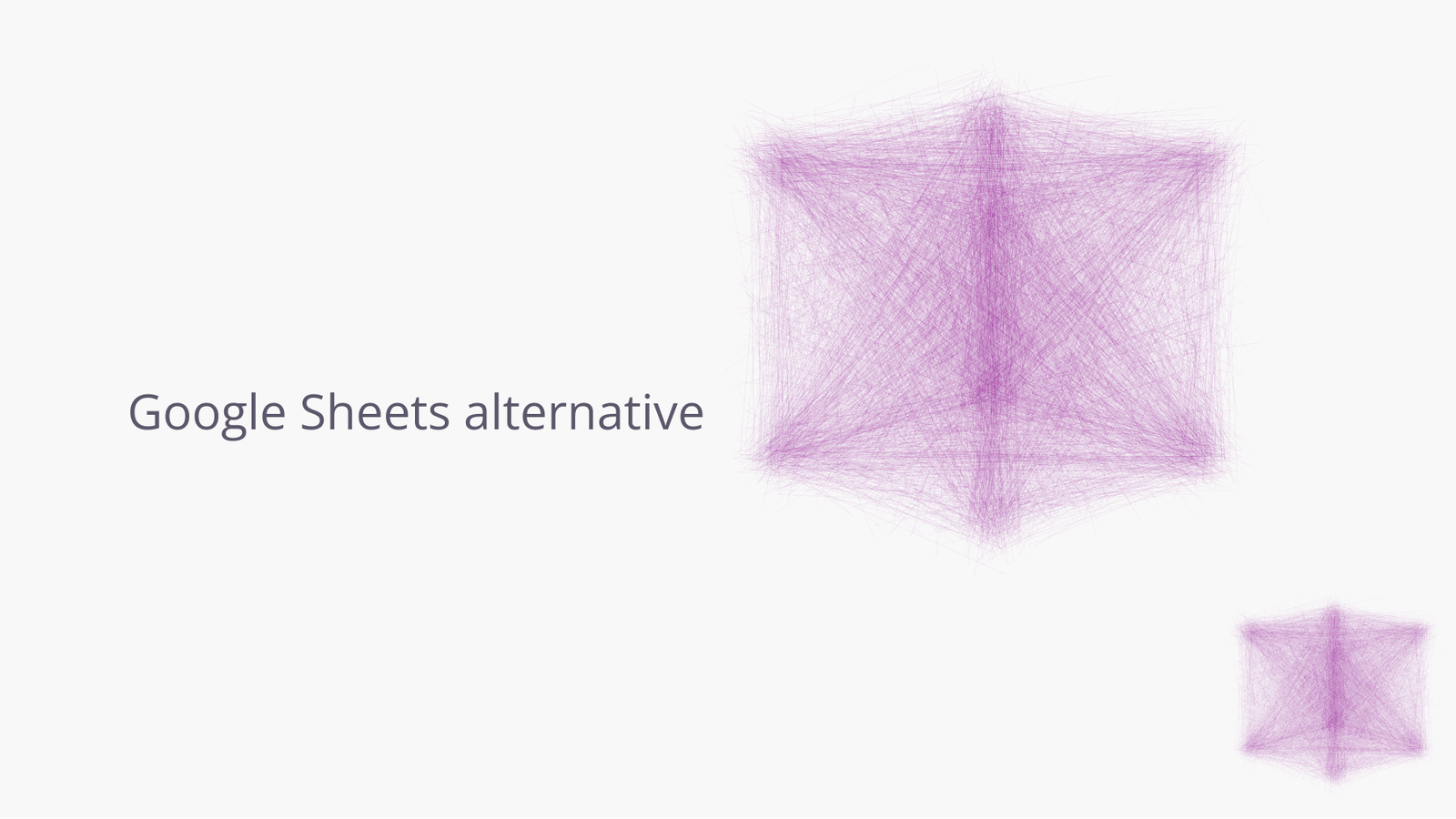Tyler Von Harz, Community Partner
Apr 2, 2025

Google Sheets has been the go-to spreadsheet tool for millions, praised for its cloud-based collaboration, simplicity, and seamless integration with Google Workspace. However, as data demands grow and teams adopt more complex workflows, many are starting to feel the cracks in its capabilities and are now looking for a Google Sheets alternative that better fits their needs.
If you've ever hit a wall trying to automate a task in Apps Script, struggled to connect your sheet to a live database, or worried about compliance in a regulated industry, you're not imagining things. You’re not the only one feeling this pain. In fact, it’s pretty widespread, and its what is driving professionals across industries to seek smarter, safer, and often free alternatives to Google Sheets.
The good news? You’re not stuck. A new generation of spreadsheet platforms is emerging, offering all the core functionality of Sheets plus the modern features it lacks. Built-in coding support, real-time sync with SQL databases, advanced permissions, HIPAA compliance, and even native AI that writes your formulas and code for you.
In this article, we’ll explore what to look for in the best alternative to Google Sheets, why users are switching, and how platforms like Quadratic are reshaping what spreadsheets can do.
So, what should you look for in a Google Sheets alternative?
When evaluating the best alternative to Google Sheets, go beyond surface-level features like spreadsheet formatting or charting tools. While Google Sheets technically remains a strong player in the collaboration space, its limitations around security, automation, and integrations make it less viable for data-intensive, regulated, or fast-scaling teams.
Look for real-time multi-user collaboration with version tracking
Google Sheets is known for its real-time editing, but it begins to falter under complex workflows that require version auditing or granular user permissions. For example, while version history is available, it lacks full support for audit trails or document locking—features critical in enterprise or regulatory settings.
Tools like Quadratic improve on this by offering more structured collaboration, where changes are tracked with precision, and roles can be clearly defined.
Effective collaboration is crucial in today's work environments. An ideal alternative to Excel or Google Sheets should support multi-user editing with instant updates and version tracking, ensuring that teams can work concurrently without data conflicts. Quadratic, for example, offers collaborative real-time editing of spreadsheets, enhancing team productivity.
Pay attention to AI capabilities
AI is no longer a bonus—it’s a necessity for modern spreadsheet work. Google Sheets has limited AI features through Smart Fill and formula suggestions, but these are reactive and often inaccurate in real-world data sets. More advanced capabilities, like generating SQL queries, writing Python code, or summarizing data tables, are simply not available.
Quadratic integrates multiple AI models that go far beyond formula autofill. It can generate Python scripts, detect anomalies, summarize data tables, and even visualize patterns using natural language input.
Don’t forget about integrations and database connectivity
One of the clearest signs of a next-gen spreadsheet is its ability to integrate directly with external data sources. Google Sheets requires third-party tools or manual updates to sync with databases like PostgreSQL or Snowflake. This can create delays, errors, and inefficiencies in any data-driven workflow.
The best Google Sheets alternative, such as Quadratic, support live connections to SQL databases and APIs out of the box. This transforms the spreadsheet into a live data environment - one where cells reflect real-time updates and insights can be generated without switching tools.
Built-in coding support: Python, SQL, and more
Google Apps Script is limited, and its reliance on JavaScript syntax and cloud-bound constraints make it frustrating for users accustomed to Python, R, or SQL. It’s serviceable for basic automation—but not for true data engineering or advanced analysis.
Platforms like Quadratic integrate native support for Python, JavaScript, and SQL directly in the spreadsheet. You can write scripts, query databases, and transform data – no external IDE or connector required. Quadratic’s “IDE for data analysis” approach means your analysts and engineers can blend formulas with code and bridge the gap between technical and non-technical users in a single canvas.
The best Google Sheets alternatives and their strengths
1. Quadratic
Quadratic is a modern spreadsheet tool that blends the spreadsheet interface with a full code environment, supporting languages like Python and SQL directly within cells. It’s designed to give users the flexibility of a programming environment while maintaining the structure of a grid. Its standout feature is native AI integration, which can be used to simplify the data analytics lifecycle from end-to-end.
2. Excel
It might be old, but Microsoft Excel remains a powerhouse in the spreadsheet world, especially for data-heavy tasks, financial modeling, and complex formulas. It offers robust pivot tables, macro scripting with VBA, and —as of late—a limited rollout of native Python support for Microsoft 365 subscribers. However, its collaboration features lag behind those of Google Sheets, and syncing issues are common when multiple users edit a shared file. Real-time cloud functionality is available only through OneDrive and requires an Office 365 subscription, which can add up for teams. Learn more about Excel vs Google Sheets.
3. LibreOffice Calc
LibreOffice Calc is an open-source spreadsheet application that’s part of the LibreOffice suite. It’s completely free to use and supports Excel file formats (XLS, XLSX), along with a wide range of other formats. Calc is an acceptable choice if need a local, privacy-focused tool that doesn’t depend on the cloud.
That said, it lacks native collaboration features, has a steeper learning curve for some functions, and doesn't offer real-time integrations or AI-powered tools. While it can be extended via macros and plugins, it’s best suited for solo users or teams with minimal need for automation and database connectivity.
4. Thinkfree Office
Thinkfree Office is a web-based office suite that includes a spreadsheet application similar in interface to Excel. It provides basic spreadsheet functionality along with the ability to edit Microsoft Office files. Because it runs in the browser, it’s accessible across platforms, but its development appears slower than competitors, and its user base is relatively niche.
Thinkfree’s spreadsheet tool lacks advanced features like real-time collaboration, native database connections, or AI tools. As of now, it's more of a lightweight substitute than a comprehensive Google Sheets alternative, and long-term support may be a concern for some users given its limited market visibility.
The future of spreadsheets: smarter, safer, more connected
The future is bright for not just spreadsheets, but managing data in general. Here are some of the ways we’re seeing the tech advance before our eyes.
Spreadsheets and low-code tech are merging
As Gartner predicted, by 2025, 70% of new applications developed by enterprises will use low-code or no-code technologies, and spreadsheets are rapidly becoming part of that movement. Platforms like Airtable and Quadratic are at the forefront, with deeper logic and API interaction without requiring full-stack development experience.
The traditional spreadsheet is evolving beyond rows and columns into something more dynamic and programmable. Modern alternatives to Google Sheets are increasingly merging the flexibility of spreadsheets with the structure of databases and the simplicity of low-code platforms. This hybrid model means you will be able to manage relational data, automate workflows, and trigger actions across systems all within the familiar spreadsheet interface.
Compliance is a huge point of concern
As industries become more regulated and data governance more complex, security and compliance are now non-negotiable. While Google Workspace can be configured to be HIPAA compliant, doing so requires administrative oversight, signed agreements, and careful permission controls—making it error-prone and unsuitable for many organizations out of the box.
The HIPAA Journal has cautioned against using Google Sheets for protected health information unless these conditions are explicitly met.
This compliance gap is pushing organizations toward more secure Google Sheets replacements, particularly in healthcare, legal, and finance sectors. Emerging platforms like Quadratic offer HIPAA and SOC 2-compliant environments with fine-grained access control, self-hosting options, and overall compliance by default — making them a more reliable choice for sensitive data workflows.
Why Quadratic is the perfect Google Sheets substitute?
As we pointed too, AI is taking over spreadsheet technology and making room for a lot more possibilities. Static formulas and manual functions have long defined spreadsheet work, but that’s quickly changing. The next generation of spreadsheet tools are embedding AI to interpret natural language commands, generate queries, recommend formulas, and even summarize datasets.
Where Google Sheets relies on manual formulas or limited scripting through Apps Script, Quadratic introduces a more flexible environment by supporting Python and SQL natively, so you can create scripts directly within the spreadsheet and interact with live data sources using code. Importing datasets is also straightforward. Quadratic supports drag-and-drop for formats like CSV and Parquet, and can also work with Excel files.
What differentiates Quadratic most is its focus on integration and extensibility. It’s designed to sync with external databases and APIs, making it more aligned with modern data workflows. It doesn’t aim to replicate Sheets’ interface but instead offers a different model – one closer to a coding environment merged with a spreadsheet canvas.
For professionals looking for a Google Sheets alternative that combines intelligent automation with advanced coding and real-time collaboration, Quadratic is the perfect solution that overcomes many of the limitations of traditional spreadsheet tools.




